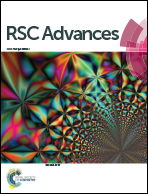Facile strategy of NCA cation mixing regulation and its effect on electrochemical performance†
Abstract
The cation mixing of LiNi0.8Co0.15Al0.05O2 materials was regulated by a facile strategy via control of oxygen flow rate during sintering. The cation mixing first decrease and then increased with the increasing oxygen flow rates. The effects of cation mixing on the electrochemical performance of LiNi0.8Co0.15Al0.05O2 materials were studied in detail. Their initial discharge capacities, rate capabilities and cycling retentions (both at room temperature and 55 °C) increase with decreasing cation mixing, and then decrease with increasing cation mixing, while their Rct (charge transfer resistance) and oxidation/reduction peaks of the CV curves reveal the opposite trend. LiNi0.8Co0.15Al0.05O2, which possesses the smallest cation mixing, had an initial discharge capacity of 191.3 mA h g−1 with 86.4% coulombic efficiency at 0.1C rate between 2.8 V and 4.3 V (vs. Li/Li+), which was maintained at 144.1 mA h g−1 and 139.1 mA h g−1 after 300 cycles at 1C rate at 25 °C and 55 °C, respectively. It is clear that the NCA sample with smaller cation mixing presents better electrochemical performance.


 Please wait while we load your content...
Please wait while we load your content...